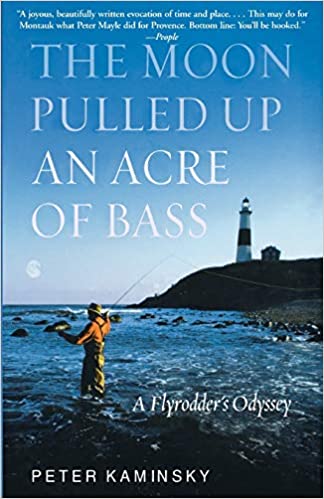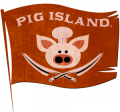Peter Kaminsky has written about everything from fly fishing to open fire cooking and the beauty of bacon. He’s co-authored cookbooks with some of the biggest names in the business including Daniel Boloud, Gray Kunz and Francis Mallman. He’s also a television producer, avid home cook and longtime friend of Food Karma Projects. We talked with Peter about how he got into food writing, his book Pig Perfect and what he’s been cooking throughout the pandemic.

Food Karma: How did you get into writing about food?
Peter Kaminsky: I’ve always cooked. In 1994 I did a series for the New York Times called “The Season on the Harbor”and every month I’d fish a different place in New York City waters. In December, the last one, I would always have a Christmas lunch with my Princeton freshman roommate. I took my daughter Lucy out fishing for blackfish, which is a local fish, on a party boat out of Sheepshead Bay. This guy Eddie Dols, a blackfish addict, was on the boat and he showed us how to do it, it’s a little tough. He had been the walrus keeper at the aquarium.
We caught a lot of fish, so I called up Michael Lomanaco who at that time was at the 21 Club. I knew him because he had contacted me once about fishing. I told him I had 12 blackfish and asked if we could come in and have lunch. He would cook the blackfish and sell the other ones. He said sure, so we went and had a great lunch. I had my little Igloo cooler. I went to check my coat, and Frank Gifford and Ethel Kennedy were behind me, and I remember they asked if I had brought my lunch. I said, “As a matter of fact, I did”
We had a great lunch. I remember there was something with white truffles. When the Times ran it, they gave me more space than they ever gave me, it was most of a page and there were pictures of Eddie fishing and Michael flipping pans. I got a lot of mail from that and I didn’t get much mail. I probably got more mail from that than anything I wrote except my 9/11 column. A little lightbulb went off, and I said, “People like food,” so I became a food writer. My brother and I produced television shows and we had an office above Union Square Cafe and we ate there three or four times a week. They were going to open Gramercy Tavern, so I got an assignment to write about that and it was the cover of New York magazine, so I was a food writer.
FK: Did you have to change the way you approached writing?
PK: Not really. I’ve always written first person stuff, or that’s what I write most easily. As with fishing, when I started to write about chefs I was not the expert so I wasn’t in competition with them. When you enter with that kind of attitude the doors are open. It was easy to have access.

FK: How did you get the idea for Pig Perfect?
PK: I had written a couple cookbooks already. In 1997 or 1998, my agent said, “If I could get you the money to write anything what would you write?” I said I would really like to spend the month of October in Montauk because it’s the greatest wildlife migration on earth. All the bass, all the whales, all the tuna, all the monarch butterflies, all the ducks and geese pass through. So I wrote a book where I fly fished every day and wrote about the natural history and human history of the East End of Long Island which is called The Moon Pulled Up an Acre of Bass.
Hyperion, the publishing company, asked if I had an idea for another writing book about food, I think were the words they used. As happens, I was taking a shower and was thinking about how every time I’ve been on the road for a fishing story, like for Field and Stream or Outdoor Life, if I was in a part of the country where they made ham, I’d always see if anyone made a good local ham.
In the pitch letter I talked about being in the Ozarks and staying in this house where the woman who owned it made ham and another time when I was writing about panning for gold in the Chattooga river in Georgia, which was the first gold strike in the US, about finding ham at a gas station there. So I said, “I’d like to go find the perfect ham,” and they were charmed by that idea, so I got a book contract.
In looking for the perfect ham, I realized a lot depended on the pig that went into it, and that’s how I ended up traveling all around and learning about pig husbandry and their penchant for acorns making really good, delicious flesh and healthier fat. That’s how it happened: I went in with one idea and it developed into a broader one.
FK: Who did you write the book for?
PK: You know, I never asked myself that, which is probably why I’m not rich. It was just something that really interested me, and they paid me enough that I could do it. I really enjoyed it and I learned things.
FK: Our friend Tank Jackson loved the book and was so excited to meet you at Pig Island a few years ago. Did you think about if the book was aimed at professionals or those with just a hobbyist’s interest?
PK: I loved ham. My grandma always used to bring ham when she came and visited us. She had a grocery store in Kearny, New Jersey and she would take the bus to West Orange. Then I was sitting in a doctor’s office and there was an article in Esquire by James Villas about country ham and about how it was this great American delicacy that really intrigued me. Then the character Nero Wolfe is invited to give a talk to this American gastronomic society in West Virginia at this wonderful old mountain resort, it’s a country house murder mystery, but in it he gives this speech about America’s contribution to the world’s cuisine. He talks about terrapin stew and chickens in Georgia fed on blueberries and country ham.
Those things got me on the ham trail. At that time, the only place you could buy country ham in New York City was in Chinatown. I kind of had an affinity for it, so when they asked for a book it was really no more than I had this idea and put it in a letter and they already knew me and said it sounds good, go do it.

FK: What should people know about country ham?
PK: The first thing is it’s delicious. The time I’m talking about, it’s going back some to maybe 1980, country ham by law had to be aged for a year and a day. Any food that benefits from aging like cheese, like wine, like ham develops more complex flavor. It’s more sensorially satisfying is the way to put it.
Prosciutto doesn’t have to be aged or aged that long. The step up from country ham is the Spanish hams or the Italian culatello because they’re made in a dryer climate, well the Spanish hams are, they don’t need as much salting, they don’t need to be smoked and the culatello has the bone taken out, as the prosciutto does, so even though its aged, it again needs about half the salt of Spanish ham which need about half the salt as American ham. The salt is good, but you get a balance of sweetness and that aged funk from those hams.
FK: What’s changed since you wrote the book?
PK: I think the book holds up. It wasn’t a huge bestseller, but a lot of pig farmers and chefs and people who became cooks and chefs read it. It certainly galvanized a lot of people to try to get those Ossabaw hogs that I wrote about. A lot of people got into more sustainable farming, letting them graze, letting them get bigger and fatter so they’re more marbled and, where possible, they let them graze on acorns. The old country hams that I spoke about that need to be aged a year and a day also needed to be fed peanuts. Like acorns, that really imparts some flavor to the meat and some delicious fat, although acorns are the less saturated fat.
FK: How did you get connected with Jimmy?
PK: Hyperion set up dinners all around the country, and for one of them they set up a pig dinner at Jimmy’s restaurant. We got to talking there, and he’s obviously both enthusiastic and informed and on the side of the angels, which is of food, so that was an easy connection to make. He invited me to Pig Island on Govenor’s Island, and I thought it was really great. One of the things I thought was great about it was it cost a lot of money. It wasn’t like mortgage money, but it wasn’t like five dollars and all you can eat, so the crowds weren’t like Big Apple Barbecue, which is a wonderful event but the lines can get really long. You could get to everything at Pig Island, and there was some really good food there.

FK: Do you have any thoughts on cooking during the pandemic?
PK: I think in the pandemic people cooked more and baked more and people cooked outside more. I think they’ve honed their skills. I’ve certainly become a better baker and I learned how to make a tortilla española, which I never had the guts to flip over. I think a lot of people have learned some new skills and I think they’ve become better at it.
I also think, much we all miss restaurants, we’ve learned to appreciate just simple, delicious food. Delicious ingredients taste more delicious, and that’s certainly true of pork, I guess it’s true of any meat, but you need to start with great ingredients. Factory ingredients may be cheaper, but in the long run they don’t satisfy you. I would hope that people have begun to learn that lesson, that complicated food is okay when you go out for complicated food, but you don’t need it all the time. You can be really happy with simple stuff, which is what I got to write about with Ned Baldwin in my latest cookbook How to Dress an Egg: really great, simple, just delicious ways to make food. I’ve written I think 18 cookbooks with some great world class chefs, but that’s the one that’s really affected my home cooking most.
